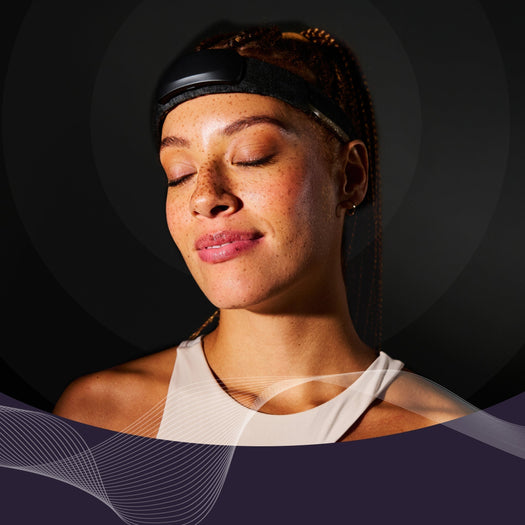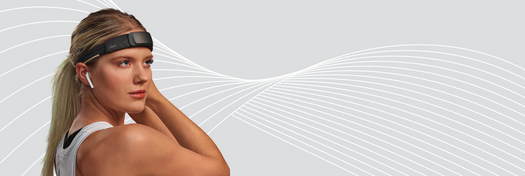What is Neurofeedback and Biofeedback?

Your brain is constantly sending signals. What if you could hear them — and respond in real time?
That’s the promise of biofeedback and neurofeedback - and it's not just for physicians or doctors anymore.
These evidence-based technologies translate your body’s internal signals into real-time data — enabling measurable shifts in focus, calm, and recovery.
Studies have shown that neurofeedback can reduce symptoms of anxiety by up to 60% and significantly improve attention and working memory in both clinical and non-clinical populations[1] [2].
Meanwhile, consistent use of biofeedback — especially heart rate variability (HRV) training — has been associated with improvements in blood pressure regulation, autonomic balance, and sleep quality, by teaching individuals to consciously adjust their physiological responses to stress [3].
By harnessing these tools, you’re not just monitoring your state — you’re training your nervous system to optimize performance under pressure.
At Muse, we specialize in real-time brain training powered by neurofeedback, helping users monitor and optimize their mental states with every session.
In this guide, we’ll break down the difference between biofeedback and neurofeedback, how they work, and how you can use them to upgrade your mental fitness.
Brief History of Neurofeedback
Beginning in the 1950s, medical researchers began to experiment with patient-controlled methods to decrease epileptic seizures. Decreased seizure activity was linked in numerous studies to calming brain wave activity through self-produced brainwave changes [4].
Neurofeedback—initially promoted as an aid for epileptic adults—became utilized in the conduction of research on meditation practitioners (in order to better understand the brain wave changes occurring during meditation sessions).
The result was an increased understanding of the positive physiological effects of alpha brain waves, and the general health benefits of meditation.
Technological advances in EEG (electroencephalogram) diagnostics has enabled neurofeedback to provide information valuable to enabling people to potentially increase their alpha wave prevalence (and decrease the typical beta wave level that is characteristic of wakefulness).
This means people can now learn how to shift their mental state — from stressed and distracted to calm and focused, just by seeing what’s happening in their brain and adjusting in the moment.
Now, our newest device, Muse S Athena builds on this progress by combining EEG with functional near-infrared spectroscopy (fNIRS) — a technology that measures blood flow in the prefrontal cortex to assess cognitive workload and emotional regulation.
Research shows that integrating EEG and fNIRS provides a more complete view of mental states by simultaneously capturing neural electrical activity and brain oxygenation levels — enhancing the accuracy of neurofeedback training [5].
Learn more about this powerful combination →
Biofeedback VS Neurofeedback: What’s the difference?
Though often used interchangeably, there is a difference between the terms biofeedback and neurofeedback.
What is biofeedback?
According to the Mayo Clinic:
“biofeedback is a technique you can use to learn to control your body’s functions, such as your heart rate. With biofeedback, you’re connected to electrical sensors that help you receive information (feedback) about your body (bio).”
Types of biofeedback include [6]:
- Brainwave: Scalp sensors monitor brain wave activity using an electroencephalograph (EEG).
- Breathing: Aka respiratory biofeedback where bands are placed around your abdomen and chest to monitor your breathing patterns and respiration rate.
- Heart rate: Finger or earlobe sensors with a device called a photoplethysmograph or sensors placed on the chest, lower torso or wrists using an electrocardiograph (ECG) to measure your heart rate and heart rate variability.
- Muscle: Sensors are placed over your skeletal muscles with an electromyography (EMG) to monitor the electrical activity that causes muscle contraction.
- Sweat glands: Sensors attached around your fingers or on your palm or wrist with an electrodermograph (EDG) measure the activity of your sweat glands and the amount of perspiration on your skin, alerting you to anxiety.
- Temperature: Sensors attached to your fingers or feet measure your blood flow to your skin.
The amazing thing about this type of feedback is that is can help the subject gain understanding and awareness about their ability to directly impact their physical state, with their thoughts alone.
The feedback helps them to be able to focus on the subtle changes such as breath, focus, and relaxation of certain muscles to help achieve specific results.
What is Neurofeedback?
Neurofeedback is a form of biofeedback that focuses specifically on brain activity. It uses EEG sensors placed on the scalp (or in the Muse S 2 Headband) to monitor brainwave patterns in real time — showing how your brain responds to focus, stress, and relaxation.
You then receive feedback (like audio cues or visuals) that helps you train your brain to shift into more balanced states — such as increasing calming alpha waves and reducing overstimulated beta activity.
-
Neurofeedback can lead to a 45–60% reduction in anxiety symptoms in clinical settings [7]
-
A 2020 meta-analysis found it effective for improving attention, memory, and cognitive flexibility in both neurotypical and clinical populations [8].
-
After consistent training, users report better emotional regulation and focus, often within just a few weeks [7] [8].
Over time, neurofeedback helps the brain become more resilient, adaptable, and self-regulating supporting long-term cognitive and emotional performance.
So, you can think about biofeedback as more of a general umbrella term and neurofeedback is specific to EEG readings.
Positive Real-Life Impacts of Daily Neurofeedback
Described in an article in the Journal of Neurotherapy [10] as physical therapy for the brain, a daily session of neurofeedback can produce positive brain wave changes that can improve mental and physical functioning.
Both meditation and neurofeedback—through decreasing beta wave activity—increase cognitive functioning in areas such as concentration and problem-solving.
The laboratory of Prof. Michela Balconi at the Catholic University of Milan sought to understand whether using neurofeedback with Muse daily for several weeks, would show measurable differences when compared to a group using a simple relaxation exercise. Their results were published in a series of two papers in 2017 and 2018.
Members of Prof. Balconi’s lab studied 40 participants over four weeks. Half of the participants used Muse for meditation daily, and the other half (the control group) performed a daily deep breathing exercise while listening to recorded sounds of nature. At the outset, and at the end of weeks two and four, participants underwent high-density EEG and performed a series of cognitive tests, as well as measures of stress.
Prof. Balconi’s study revealed several interesting results:
- The group using Muse showed an improvement in response times in a complex reaction task – they got faster at a cognitive task.
- Participants using Muse showed changes in their resting brain states, similar to the changes seen in the brains of mindfulness meditators by other researchers, and suggesting an improved control of participants’ ability to relax.
- The participants in the Muse group showed brain plasticity changes indicating, according to the researchers “markers of neural efficiency and information-processing were significantly greater for [Muse] training than control participants.”
- Compared to the control group, the Muse group showed a significantly larger reduction in stress – a 16% reduction in perceived stress in just four weeks.
Note: You can find the original published papers from the Balconi Lab study HERE and HERE.

Muse Feedback VS. Traditional Neurofeedback
Many people often ask if the Muse headband and Muse app offer traditional neurofeedback.
The short answer is no — the algorithm that Muse uses to provide real-time feedback during meditation is more advanced and adaptive than traditional frequency-based neurofeedback.
In creating the Muse app, we started by looking at individual brainwaves and then spent years doing intensive research — with hundreds of hours of meditation data to explore how primary, secondary, and tertiary characteristics of raw EEG signals interact with focused-attention practices.
From there, we developed a machine-learning algorithm that uses each bandpower in a unique and complex way, mapping brain activity to distinct mental states like calm, active, and neutral.
While traditional neurofeedback focuses on training isolated frequency bands (like alpha or beta), Muse goes further by interpreting interactions between multiple brainwave patterns to deliver nuanced, real-time insight into your state of mind.
How feedback from Muse Can Help
Meditating while wearing the Muse headband (connected to a free app on a mobile device) can enable a user to view their brain wave patterns after a session of focused attention meditation.
During their session, and by focusing on their breath, a fundamental aspect of focused attention meditation, they can listen to subtle guiding sound cues to reach the desired focused brainwave response. This helps strengthen the user’s ability to reach this state during everyday events and, in turn, deter mind wandering or negative thoughts as well as improve quality of life.
Muse detects a full range of brainwave activity. Brainwaves are typically broken up into five bands, which Muse is capable of detecting the full spectrum of brainwave types:
- Gamma
- Beta
- Alpha
- Theta
- Delta
All of these brainwaves are used in making the analysis that Muse provides at the end of every session, giving you unique insights into every Muse session.
The science of self-awareness just got an upgrade.
Muse S Athena blends EEG + fNIRS to show you what calm feels like in real time.
Experience the feedback loop of the future → Order Muse S Athena Now
Sources:
[1] Hammond, D. C. (2005). Neurofeedback with anxiety and affective disorders. Child and Adolescent Psychiatric Clinics, 14(1), 105–123.
[2] Enriquez-Geppert, S., Huster, R. J., & Herrmann, C. S. (2019). EEG-neurofeedback as a tool to modulate cognition and behavior: A review tutorial. Frontiers in Human Neuroscience, 13, 51.
[3] Yucha, C., & Montgomery, D. (2008). Evidence-Based Practice in Biofeedback and Neurofeedback. AAPB.
[4] Sterman, M. B., Macdonald, L. R., & Stone, R. K. (1974). Biofeedback training of the sensorimotor electroencephalogram rhythm in man: Effects on epilepsy. Epilepsia, 15(3), 395–416.
[5] Ahn, S. J., Lee, S. H., & Choi, J. H. (2016). Simultaneous measurement of EEG and fNIRS during cognitive tasks for a more robust understanding of neural mechanisms. Journal of Neuroscience Methods, 271, 13–23.
[6] “Biofeedback.” Mayo Clinic, Mayo Foundation for Medical Education and Research, 14 Jan. 2016, www.mayoclinic.org/tests-procedures/biofeedback/about/pac-20384664.
[7] Hammond, D. C. (2005). Neurofeedback with anxiety and affective disorders. Child and Adolescent Psychiatric Clinics of North America, 14(1), 105–123.
[8] Rogala, J., Jurewicz, K., Paluch, K., Kublik, E., Cetnarski, R., & Wróbel, A. (2020). The do's and don'ts of neurofeedback training: A review of the controlled studies using healthy adults. Frontiers in Human Neuroscience, 14, 576134.
[9] Thompson, M., & Thompson, L. (2003). The neurofeedback book: An introduction to basic concepts in applied psychophysiology. Journal of Neurotherapy, 7(1), 5–39.
[10] Balconi, M., Finocchiaro, R., & Canavesio, Y. (2018). Neuroscientific analysis of mindfulness efficacy: EEG, cognitive and psychological evidence. Mindfulness, 9(5), 1541–1552.
[11] Balconi, M., & Crivelli, D. (2017). Meditation training with EEG neurofeedback in healthy individuals: Behavioral and electrophysiological evidence. Frontiers in Psychology, 8, 902.
